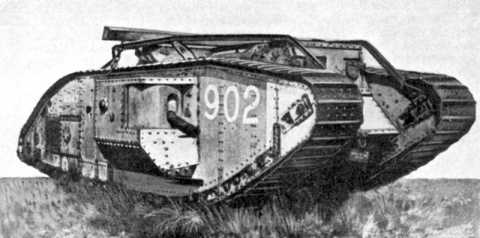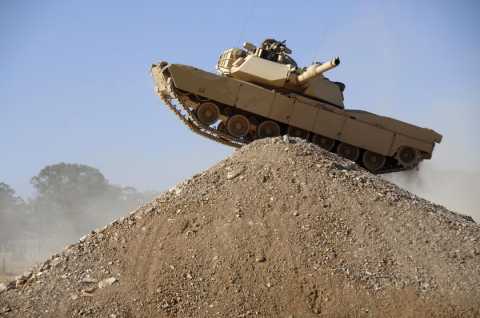Overview
 Mark V, one of the first successful tanks in the world
Mark V, one of the first successful tanks in the worldTanks are a basically mobile armoured fortresses, so-to-speak. They are the most heavily armored unit on the modern battlefield. Given the large chassis, heavy armor, and a large calibre, a tank has the potential to deal large amounts of damage to the opponent if not dealt with right off the bat.
The concept of the tank first appeared in the 19th century, well before World War I.
A reader of The London United Service Magazine in 1833 imagined the concept that would not be realised for another 80 years
“The great forte of steam is its passiveness. Secure the boiler and the machinery from the stroke of a cannon-ball, and you might drive a steam-chariot triumphantly through a regiment. Imagine three or four of these machines driven at a galloping speed through a square of infantry; the director might be seated in perfect safety in the rear of the engine, and a body of cavalry, about fifty yards in rear, would enter the furrows ploughed by these formidable chariots, and give the coup-de-grace to the unfortunate infantry."
By 1916 the British and French had to find a way to breach the otherwise impregnable German trench defenses. This is where the concept of an infantry tank began.
The British designed the Mark I to combat, and while it wasn't a huge success, more than a third of the nearly 50 deployed made it through German lines.
The Mark I was basically a giant box with its guns mounted on the front or sides of the engine.
The first tanks had many problems, the armor of the Mark I had a terrible case of spalling, where razor sharp flakes would bounce around the inside even if the small calibre rounds from a pistol hit the armor of the tanks. They were also only able to move at walking speed, around 6kmh or 2mph.
Early tanks were meant to move with the infantry and attack strong points in the trench system. Throughout the 30s and into WW2 tanks were gradually developed from several classes, Tankette, Light, Cruiser, Medium and Heavy and again into the two current types by the 1950s. Main Battle Tank and Light Tank.
Armor
 M1 Abrams
M1 AbramsArmor is the key to a tank's survival, being one of many features that separate armoured cars from tanks.
A tank is a small fortress but when out on the battlefields, you have to depend on your "shell" to get you through the battle in one peice. There are different types of armor; the most well known being RHA, or Rolled Hom.
Armor which acts as sort of a base build that many other systems build and compare there systems to, it is also a testing module for future tank guns. Tank armor takes alot of influences back in the day, as you take a general look at tanks today, they all utilize sloped armour, this technique was developed by the Russians back in world war II, it was a simple idea, but a very effective and influential design that countered every tank the Germans had, another technique is the cages armour with protects tanks from shaped charges, or Rocket Propelled Grenades, another technique developed in WWII, this technique was used by the Russians to counter the Panzerfaust (Tank Fist) Rockets that could decimate T-34's at 20m.
Mobility
Speed and agility are not usually associated with tanks. Early tanks in WWI could rarely move more than 5km/hr. Tanks throughout the interbellum were redesigned for a multitude of roles, with most work being done in the USSR and Germany. Light and fast tanks were used often in Germany's invasion of France and won there mostly because of their ability to bypass the French formations and get into the French rear areas. Although vulnerable to the allied tanks of the day, the Germans had better use of air support and after the initial breakthroughs the French were disheartened. Soviet light tanks fared poorly during the invasion of Finland in '39-'40 and again when the Soviets were invaded by Germany. Poor experiences with the other powers in WW2 led to the abandonment of the fast, light tank concept. Mobility as it turned out is no substitute for firepower and armour.
Armament
 Tanks can be very useful if driven by competent players.
Tanks can be very useful if driven by competent players.Tank weapons have changed along with their mission during the century since their invention. Early tanks used small artilery pieces as well as machine guns to support infantry in close assualts. Throughout the inter war and Second world war periods, tank armament changed rapidly along with the rest of their design. Small calibre high explosive guns used on earlier tanks proved useless against enemy tanks and tanks moved from infantry support to being used to counter enemy armour (along with specifically anti-tank vehicles) and for spearheading attacks ahead of infantry, not with them. Tanks that used multiple guns (Grant/Lee) faired very poorly against the German armour which had always single more powerful gun, and sponsons were phased out completely in favour of a turret. The single powerful gun is still a feature of tanks today. The arms/armour race between the Warsaw Pact and the NATO allies nations culminated in steel/ceramic laminates that were all but immune to large calibre 125mm shells from tanks only fifteen years earlier. In the Gulf War of 1991, M1A1 Abrams tanks were able to defeat superior numbers of Iraqi T-72s and taking no losses. The smaller calibre but incredibly high penetration of the Depleted Uranium rounds used proved lethal to the opposing tanks.
Use in video games

Tanks appear in a wide variety of games in various capacities. In simulations and RTS titles they are fulfilling roles close to their real life counterparts, mobile gun platorms that are generally expensive, strong against infrantry and light vehicles, but vulnerable to aircraft and uneven terrain. The game Men of War features tanks realistically modeled with armour deflecting shots instead of a health bar, it also shows that a heavy tank can be knocked out by a single man with a lucky AT grenade or molotov cocktail. Action games and FPS may also feature tanks in these realistic situations, but just as often they will constitute a boss fight with a health bar. Vulcan Raven is piloting a tank in an exaple of such a battle in Metal Gear Solid. But it is Metal Gear Solid: Peace Walker that features the most Metal Gear-y tank, which is also a cardboard box.
Fun Notes
- Often in Sci-Fi RTS there will be at least one tank with dual cannons
- The most common tanks found in games are the T-72, M1 Abrams, Panzer IV, Panther Tank, and Tiger Tank.
- The most produced tank of all time is the Soviet T-54. An estimaed 86 000 -100 000 were built, and its still in service today.
Log in to comment